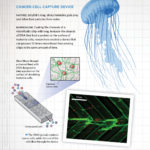News, Inspired by Nature: Researchers are borrowing designs from the natural world to advance biomedicine.
When biomedical engineer Jeff Karp has questions, he looks to animals for answers. In 2009, Karp gathered his team at the Brigham and Women’s Hospital in Boston to brainstorm novel ways to capture circulating tumor cells (CTCs) in the bloodstream. They mulled over the latest microfluidic devices. Then the conversation turned to the New England Aquarium, and to jellyfish. Within a year, Karp and his colleagues had designed a microfluidic chip on which 800-micron-wide microchannels are lined with long, tentacle-like strands of DNA that bind a protein on the surface of leukemia cells as they pass through the channels. The jellyfish is far from the only intriguing organism to have served as a blueprint for scientists in the field of bioinspired medicine. Researchers have taken cues from the adhesive chemistry perfected by mussels and marine worms to create tissue glues that stick in wet and turbulent conditions; from red blood cell membranes to help drug-carrying nanoparticles avoid immune attack; and from the slippery slides that help carnivorous pitcher plants catch prey to produce novel antibacterial surfaces. Nature, it seems, provides a compendium of biomedical solutions. Looking to nature is not a new concept, and bioinspiration is just one of several approaches bioengineers employ to devise new medical treatments and devices.
Learn about our two Decals!
 Click here to find out more about our Fall Bioinspired Design Decal and our Spring Bioinspired Design in Action Decal – ALL MAJORS are welcome.
Click here to find out more about our Fall Bioinspired Design Decal and our Spring Bioinspired Design in Action Decal – ALL MAJORS are welcome.Berkeley BioDesign Community
 Click here to learn about the BioD: Bio-Inspired Design @ Berkeley student organization or here to signup for more info.
Click here to learn about the BioD: Bio-Inspired Design @ Berkeley student organization or here to signup for more info.Search
Student Login





I imagine that the neurological circuits underlying these processes are governed by both 2d spacing maps with their brains as…
to reduce the impact of car accidents, it may be possible to study the force diverting physics of cockroaches to…
you see this type of head-bobbing stability in many avian creatures related to pigeons like chickens. the head ability to…
not like they taught horses how to run! this is an example of convergent evolution where both sea creatures and…
The brain functions in a similar way with neuronal connections. our brains are able to utilize the multiplicity of connections…